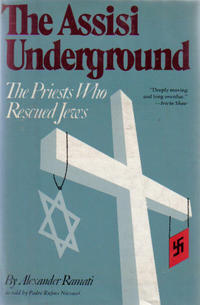Plot
In the Italian town of Assisi during World War II, 300 Jews were sheltered and protected by a peasant turned priest, Father Rufino Niccacci. He dressed many of them as monks and nuns, taught them Catholic ritual, and hid them in the monasteries. Others lived in parishioners' homes and, with fake identity cards, found jobs and blended into the community. The town's printing press, which during the day printed posters and greeting cards, at night clandestinely printed false documents that were sent by courier to Jews all over Italy.
Not a single refugee was captured in Assisi. No one who participated in the rescue operation ever betrayed it.
The operation was aided by the German Commandant of the city, Colonel Valentin Müller [ it ] a Catholic, who had been persuaded by Father Rufino that he had been sent to the town not only by the German High Command, but also by God, with the mission of protecting the Christian holy places and monasteries. Müller appealed to Marshal Kesselring to declare Assisi an open city.
When the Allies began approaching the city, one of the Jewish refugees, whose German was so excellent that he had gotten a job with the Wehrmacht, forged a letter from Kesselring declaring Assisi an open city. The colonel never suspected it to be a forgery and immediately ordered all German troops to leave town, thus saving Assisi from destruction.
This page is based on this
Wikipedia article Text is available under the
CC BY-SA 4.0 license; additional terms may apply.
Images, videos and audio are available under their respective licenses.
